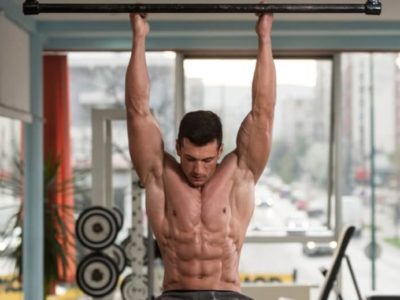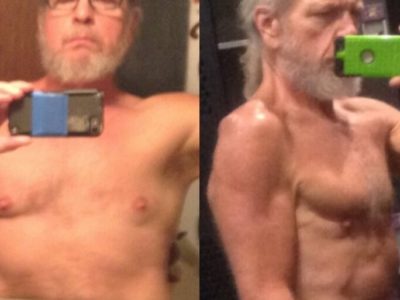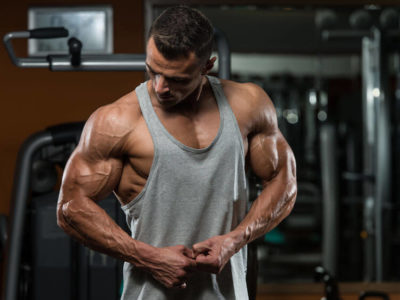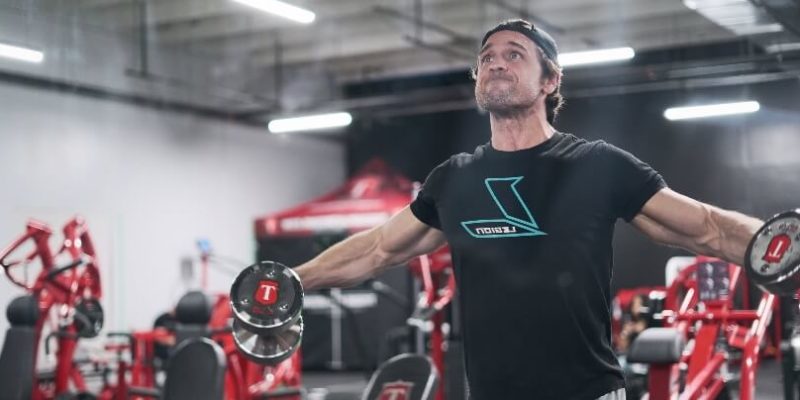
Key Takeaways
- You can boost your strength (and skill at any other sport) by using a form of mental practice known as “active imagery.”
- The most effective way to implement active imagery is to use a seven-part system known as PETTLEP, which is an acronym that stands for physical, environment, task, timing, learning, emotion, and perspective.
- Keep reading to learn how to use each aspect of PETTLEP to boost your performance in the gym!
Let’s say you want to get better at a physical activity, like shooting a basketball.
What should you do?
Practice, right?
Certainly.
But did you know you can further improve your skills by picturing yourself making baskets?
If that sounds like hocus pocus, I’m with you. But “mental practice” has been an area of scientific interest for a couple of decades now.
It’s referred to as “active imagery,” and research going back to 1994 has shown that visualizing yourself doing something can improve your ability to do it.
The exact mechanisms of how this works aren’t fully understood yet, but we know that picturing yourself performing a task can elicit similar brain activity as doing it.
This is significant because the “muscle memory” that many people speak of in motor learning goes much deeper than just the muscles involved. Research suggests that the more often you perform actions, the more often certain areas of the brain are activated.
What type of picturing works best, though?
How do you make mental practice effective?
And what does all this have to do with weightlifting?
As scientists and athletes became more aware of the value of active imagery, they started asking questions. They wanted to know which techniques worked better than others and how to get the most out of mental preparation and practice.
This led to what we now consider the gold standard for active imagery: PETTLEP.
That’s an acronym for . . .
- Physical
- Environment
- Task
- Timing
- Learning
- Emotion
- Perspective
Let’s look at each.
Physical
This is the most important component of the model. It entails replicating the physical elements of actual practice as much as possible and seeing (and feeling) the images as physical experiences.
For example, if you want to rehearse a tennis stroke (or a squat), you can increase the physicality of your imagery by focusing on how your body will move and feel with each repetition, and you can include sensory information like the things you’d see, sounds you’d hear, and smells you’d smell.
Researchers even found that picturing yourself wearing the same clothes as when you play, standing in the same stance, and holding your racket in the same way can help as well.
Environment
Where you perform your imagery matters.
Scientists found the best results occurred when mental practice was done in an environment as close to the performance environment as possible. They did some of the most effective imagery experiments in the actual competitive arenas themselves.
Another good example is a creative study conducted with golfers that had one group stand in golf shoes in a tray of sand and mentally rehearse hitting bunker shots. After six weeks, scientists found that active imagery was as effective at improving bunker play as physical practice itself.
This is impractical for most of us, but we have other options. For example, using video and audio to help replicate the environment helps to increase the effectiveness of the imagery.
Task
The content of the imagery should be specific to the skill and focus level of the performer. That is, if you’re still trying to learn simple tasks, don’t imagine performing complex ones.
Timing
This refers to the speed of the imagery. Timing is a crucial aspect of sports, so the general recommendation is to run your imagination at “real time” speed.
That said, research shows that slow-motion imagery has several uses. For example, it’s particularly effective for first developing a skill, correcting faults, and refining technique, because it allows you to focus on each element of the movements.
Learning
The substance of the imagery should change as your skill improves, so what you see, hear, smell, think, and feel in your mind’s eye must replicate real life as closely as possible.
As you become better and more perceptive, attuned to the actions in real life, you must do the same in your imagery. Without such updating, the workability of visualization declines.
Emotion
The more emotion-laden your imagery is, the more effective it will be. Not just any emotions, though—the realistic emotions you would expect to feel while performing the task.
(It was hypothesized that “overriding” realistic emotions with relaxation instead would produce superior results, but this didn’t pan out in research.)
Perspective
This refers to the actual viewpoint of the imagery—viewing from inside your head (first person) or from an external position (third person).
Most experts recommend first person imagination, because it most mimics performance conditions. For some form-based-skills, such as gymnastics, however, an external perspective can also be beneficial.
Individual preferences mattered, too. Some people find first person difficult, or like third person more and get better results with it.
Example of Effective Active Imagery

If you’re feeling a little topsy-turvy after that breakdown, I understand.
PETTLEP has quite a few moving parts, and it can be a lot to wrap your wits around.
I’ll share an example from Dr. Stephen Walker, a sports psychologist, researcher, and coach, to help you get a better grasp on how to apply all this.
Dr. Walker was working with a high school high jumper named Yanda who had “fallen into a slump.” After a banner sophomore year, her performance stagnated, and she’d become frustrated, stressed, and desperate.
“We got VERY PRECISE with the pre-jump routine using PETTLEP,” Dr. Walker wrote, “and we went over it multiple times until she felt both comfortable with the process and could repeat it with precision.”
The process started with audio recordings Dr. Walker created to help guide Yanda through the process of active imagery for her sport, and then mostly involved replicating various aspects of her performance during everyday activities.
For example . . .
- She’d skip down the hall between classes “closing her eyes and jumping to experience the feel of the spring in her legs.”
- She wore running shoes similar to her track spikes every day, so that over time, they felt more comfortable and normal.
- She repeated her pre-jump routine— “find your spot,” “see your steps, “hips up in the leap,” etc. —throughout the day and before every jump in practice.
- During practice, she had someone time all her jumps with a stopwatch to precisely replicate the same timing and rhythm she would use in competition.
- She had teammates and her coach take videos of her so she could scrutinize every angle, every movement, every opportunity for improvement.
Not only did this system help Yanda consistently execute better technique, it also helped her identify mistakes she didn’t know she was making and find new ways to improve her skills.
“She began to notice details about her jump that had previously been unavailable to her,” Dr. Walker explained, “ . . .[She] became more focused on learning from each jump—and in preliminary competitions she made a game of performing efficiently with the fewest number of jumps necessary to win.”
And perhaps best of all, Yanda began to enjoy her sport again and perform at a high level, setting new personal and even school records.
How to Think Yourself Stronger
If we can improve our athletic skills with our imaginations, what about our strength?
Absolutely.
For example, in one study conducted by scientists at the University of Texas at San Antonio, young, untrained individuals improved their biceps strength by using active imagery techniques to imagine flexing their biceps as you would in a biceps curl.
Some of the participants mentally “urged the elbow-flexor muscles to contract maximally,” whereas others “visualized putting the forearm under a heavy table and then tried very hard mentally to lift the table.”
The result?
After six weeks of 15 minutes of imagery per day (only eight hours of total practice), active imagery alone increased their biceps strength by about 11%.
Keep in mind, however, the subjects were healthy but non-exercising folk, so we can’t assume this would work equally well in well-trained individuals. But the mind can clearly influence muscle.
In another study more relevant to us lifters, scientists at the University of Lyon recruited college athletes to a workout program comprising the leg press and bench press, and split them into two groups.
- Group one used active imagery techniques to imagine performing sets while resting in their workouts.
- Group two didn’t use active imagery techniques while resting in their workouts.
After four weeks, the active imagery group gained more strength on the leg press, but not the bench press.
Why the disparity?
The researchers offered a few explanations, but the most plausible was that the leg press is easier to learn and more comfortable for most people.
After all, none of these athletes had lifted weights before, so it’s likely they were a lot more confident pushing a heavy sled with their legs than holding a heavy barbell over their throats.
The bench press is also a technically demanding exercise, so it’s possible active imagery would have helped more if they were given more time to practice.
Another great example of the effects of active imagery is a study conducted by scientists at Bishop’s University with thirty male university athletes, including football, basketball and rugby players.
The men were randomly assigned to one of three groups:
- Group one used active imagery to strengthen their hip flexor muscles.
- Group two used weight machines to exercise their hip flexors.
- Group three did neither mental nor physical training.
After two weeks, the group using the weight machines increased their strength by 28%, and the group doing just mental practice increased theirs by 24%.
Yes, in college football players, thinking about training was about as effective at improving strength as heavy weightlifting.
So, how can we use all this information to improve our weightlifting? Let’s break it down.
1. Do active imagery when you’re in the gym.
You can do it elsewhere, too, but this is the easiest way to fulfill the physical and environmental criteria of the PETTLEP model.
It’s perfect—you’re wearing your workout clothes, you’re in your workout shoes, and you’re in the performance environment. An easy time to do your “mental sets” is in between your physical sets, while you’re resting.
Read: How Long Should You Rest Between Sets to Gain Muscle and Strength?
2. Vivid imagery is the key.
For mental practice to be effective, it needs to be as lifelike as possible.
Let’s say you’re going to rehearse your squat in the first person. You want to see the entire process in your head—getting under the bar, stepping back, dropping, rising, and continuing for each rep.
You also want to feel your body move and your muscles strain against the load. You should feel the bar on your back, how your knees and hips shift, driving out of the hole, and so forth.
You should also feel the emotions—determined as you step beneath the bar, distressed as your muscles burn, and relieved and satisfied as you rack the weight.
To facilitate this, take a video or two of you performing exercises you want to mentally practice, so you have a clear picture of what you look like while doing them.
Read: How to Squat: The Definitive Guide (Plus 12 Proven Ways to Improve Your Squat!)
3. Make mental gains.
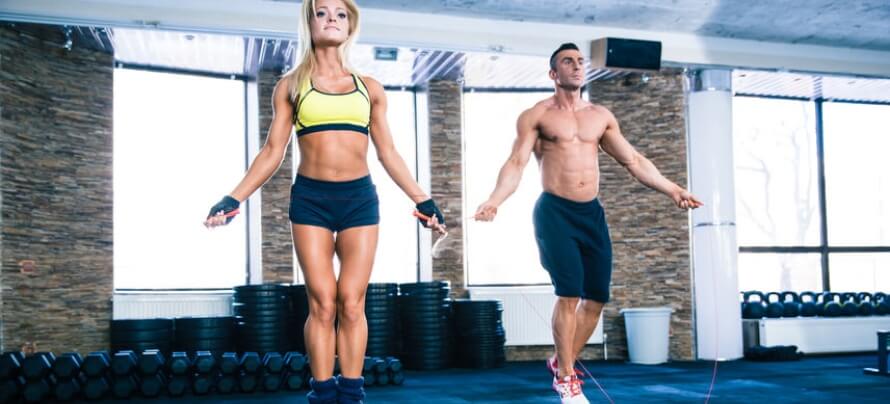
To get the most out of active imagery, you want to not only picture yourself performing an exercise, but improving on the exercise.
That is, you should imagine how it will feel to lift a weight slightly heavier than what you use now.
You should see the extra plates on the sides of the barbell. Feel the bar dig into your hands (bench press, military press, or deadlift) or back (squat). Maybe even feel the bar flex as you struggle to move it through a full range of motion.
Far from “psyching you out,” this kind of mental conditioning makes it much easier to push yourself to set PRs. In essence, you’re using your imagination to expand your comfort zone.
For example, the authors of the paper from Bishop’s University told each athlete that “this mental exercise was not simply a visualization of himself performing the task, but . . . to imagine an increase in weight lifted with each five pounds added.”
In other words, don’t just go through the motions in your mind. See yourself getting stronger, fitter, faster—facing greater and greater challenges and emerging victorious. Drill your brain to expect progress, and your body will follow.
An easy way to apply this to weightlifting is envisioning achieving your goal in the set you’re about to do.
For example, if you’re following the strength training program from my books, Beyond Bigger Leaner Stronger, your immediate goal may be a certain number of reps with a certain percentage of your one-rep max. Thus, you can visualize hitting that rep target.
(And, just to be clear, you would visualize each rep of the entire set, just as if you were doing it.)
Read: The Definitive Guide to Strength Training: How to Get Strong…Fast
4. First person or third?
Most research suggests that you’ll do well with a first-person perspective, but preference can change this.
This is especially true of more intricate exercises that require a fair amount of technical skill, like the squat, deadlift, and overhead press.
Try both and see which appeals to you the most.
5. Fast or slow?
If you’re new to a lift or still working on your form, you don’t have to use slow-motion visualization only, but it can help.
6. Update your imagery as you improve.
As you improve in your weightlifting, certain aspects of the exercises will work on autopilot.
You’ll learn to maintain a neutral spine on your deadlift, hit your depth on your squat, keep your elbows tucked on your bench press, etc.
Your imagery should reflect this, which means you’ll be able to focus on the finer details of the movements.
Remember that your imagery should evolve alongside your physical awareness and ability. As you get stronger, for instance, your active imagery should shift from technique fundamentals (which becomes ingrained) to your tempo and the finer points of your form, like when to push your hips forward when squatting or how you manipulate the bar path when benching.
Watch Others for Even More Gains
Research has found similar phenomena to active imagery with observing movements. It would appear you can improve your physical capabilities by watching other people do things, and there’s no reason to assume it works differently for weightlifting.
Try to find footage of people with a physical structure similar to yours, because it’ll help groove in the best movement patterns for your body.
If you want to use me as a model, here are a few videos of my squat, bench press, and deadlift:
Using Active Imagery to Maintain Strength
If you can’t train for an extended period because of injury or life circumstances, research shows active imagery can help you preserve your strength.
In a four-week study conducted by scientists at Ohio University, the researchers randomly divided 44 people into three groups:
- Group one had their nondominant wrist put in a cast to immobilize and weaken their forearm muscles.
- Group two had their nondominant wrist put in a cast just like group one, but used active imagery techniques.
- Group three didn’t get a cast and served as a control.
The people in group two practiced active imagery by sitting alone in a quiet room, imagining they were contracting their cast-bound forearms as hard as possible.
They did this five times per week, and in each 15-minute “workout,” the participants did four sets of thirteen imaginary maximal contractions with 1 minute of rest between each set.
The researchers measured everyone’s forearm strength and the strength of the electrical impulses from the brain to their forearms, a measure known as voluntary activation, before, immediately after, and one week after the study.
After four weeks, group one’s forearm strength and voluntary activation declined by 45% and 23% on average compared to the control group.
Group two’s results looked very different. Their forearm strength and voluntary activation declined just 24% and 13% on average compared to the control group.
The takeaway here is simple: If you’re hurt, taking time off, or unable to train for whatever reason, you can use your mind to decrease strength loss.
Bodybuilders have been talking about the “mind-muscle connection” for decades now.
What they discovered through simple trial and observation has now been fully validated by scientific research. You can influence your muscles with your mind and “think yourself stronger.”
Skeptical? Give active imagery a go in your weightlifting or sports and see what happens. It might surprise you.
***
This article is from the second edition of my bestselling fitness book for experienced weightlifters, Beyond Bigger Leaner Stronger, which is now live everywhere you can buy books online. Click here to learn more.
If you liked this article, please share it on Facebook, Twitter, or wherever you like to hang out online! 🙂
What’s your take on active imagery? Have anything else to share? Let me know in the comments below!
+ Scientific References
- Di Corrado, D., Guarnera, M., Vitali, F., Quartiroli, A., & Coco, M. (2019). Imagery ability of elite level athletes from individual vs. Team and contact vs. No-contact sports. PeerJ, 7. https://doi.org/10.7717/peerj.6940
- Smith, D., Wright, C., Allsopp, A., & Westhead, H. (2007). It’s all in the mind: PETTLEP-based imagery and sports performance. Journal of Applied Sport Psychology, 19(1), 80–92. https://doi.org/10.1080/10413200600944132
- Smith, D., Wright, C. J., & Cantwell, C. (2008). Beating the bunker: The effect of pettlep imagery on golf bunker shot performance. Research Quarterly for Exercise and Sport, 79(3), 385–391. https://doi.org/10.1080/02701367.2008.10599502
- Jenny, O., & Hall, C. (2009). A quantitative analysis of athletes’ voluntary use of slow motion, real time, and fast motion images. Journal of Applied Sport Psychology, 21(1), 15–30. https://doi.org/10.1080/10413200802541892
- Wakefield, C., Smith, D., Moran, A. P., & Holmes, P. (2013). Functional equivalence or behavioural matching? A critical reflection on 15 years of research using the PETTLEP model of motor imagery. International Review of Sport and Exercise Psychology, 6(1), 105–121. https://doi.org/10.1080/1750984X.2012.724437
- Yao, W. X., Ranganathan, V. K., Allexandre, D., Siemionow, V., & Yue, G. H. (2013). Kinesthetic imagery training of forceful muscle contractions increases brain signal and muscle strength. Frontiers in Human Neuroscience, 7(SEP). https://doi.org/10.3389/fnhum.2013.00561
- Lebon, F., Collet, C., & Guillot, A. (2010). Benefits of motor imagery training on muscle strength. Journal of Strength and Conditioning Research, 24(6), 1680–1687. https://doi.org/10.1519/JSC.0b013e3181d8e936
- Shackell Erin M., & Standing Lionel G. (n.d.). (PDF) Mind Over Matter: Mental Training Increases Physical Strength. Retrieved October 14, 2020, from https://www.researchgate.net/publication/241603526_Mind_Over_Matter_Mental_Training_Increases_Physical_Strength
- Mattar, A. A. G., & Gribble, P. L. (2005). Motor learning by observing. Neuron, 46(1), 153–160. https://doi.org/10.1016/j.neuron.2005.02.009
- Clark, B. C., Mahato, N. K., Nakazawa, M., Law, T. D., & Thomas, J. S. (2014). The power of the mind: the cortex as a critical determinant of muscle strength/weakness. Journal of Neurophysiology, 112(12), 3219–3226. https://doi.org/10.1152/jn.00386.2014
If you enjoyed this article, get weekly updates. It’s free.
Sending…
Great! You’re subscribed.
100% Privacy. We don’t rent or share our email lists.


